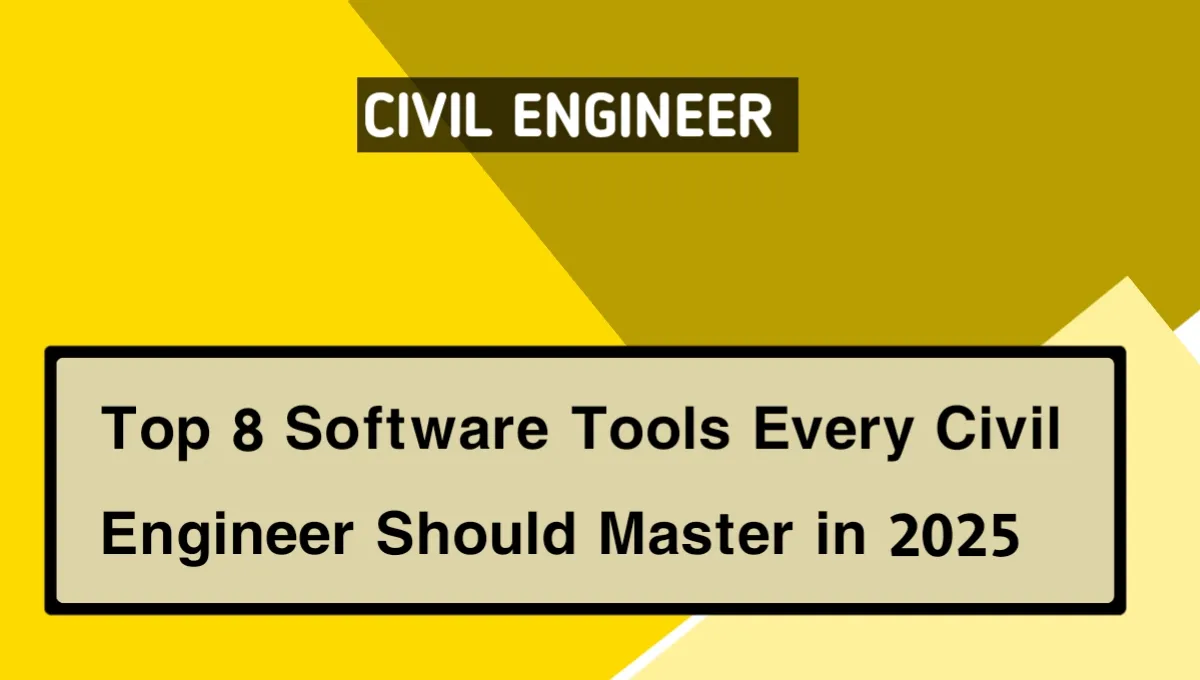Top 8 Software Tools Every Civil Engineer Should Master in 2025. This post will guide you through the top must-learn software tools every civil engineer should know in 2025, categorized by their use cases such as design, analysis, project management, and more.
In 2025, the role of a civil engineer is no longer limited to blueprints and construction sites. With rapid advancements in digital technology, modern civil engineers must master a variety of software tools to stay competitive and efficient. Whether you’re a fresher or a seasoned professional, understanding which software tools are essential can shape your career and enhance your productivity in the field.
Top 8 Software Tools Every Civil Engineer Should Master in 2025
1. AutoCAD (Computer-Aided Design)
AutoCAD remains one of the most important tools in a civil engineer’s arsenal. It’s primarily used for 2D drafting and 3D modeling.
Why Learn AutoCAD in 2025?
- Most infrastructure projects still rely on AutoCAD for detailed drawings.
- It’s widely accepted and used in almost every construction-related firm.
Key Features:
- User-friendly interface
- Integration with BIM platforms
- Industry-standard for drafting and design
2. STAAD.Pro (Structural Analysis and Design)
STAAD.Pro is essential for civil and structural engineers who focus on load analysis and structural safety.
Why Learn STAAD.Pro in 2025?
- Widely used for designing RCC and steel structures.
- Helps in checking compliance with various international standards like IS, AISC, Eurocode, etc.
Key Features:
- Real-time analysis
- Dynamic load calculation
- BIM integration
3. ETABS (Building Analysis and Design)
ETABS is perfect for multi-storey building design and structural analysis.
Why Learn ETABS in 2025?
- Preferred for modeling high-rise buildings and analyzing seismic and wind loads.
- Faster and more intuitive than traditional tools for complex geometry.
Key Features:
- 3D modeling of buildings
- Seismic and wind load analysis
- Design optimization
4. Revit (Building Information Modeling – BIM)
Revit is Autodesk’s BIM software which is reshaping how construction is managed and designed.
Why Learn Revit in 2025?
- BIM is becoming mandatory in government and large private projects.
- Revit helps in coordination between architects, engineers, and contractors.
Key Features:
- 3D model visualization
- Automatic BOQ generation
- Clash detection and coordination
5. Primavera P6 (Project Management)
Primavera P6 is a leading software for project scheduling and management used in large-scale civil projects.
Why Learn Primavera P6 in 2025?
- It’s used in large infrastructure projects like highways, railways, and power plants.
- Helps in effective resource and cost management.
Key Features:
- Gantt chart-based scheduling
- Resource planning
- Progress tracking
6. MS Project (Project Scheduling)
While Primavera is for heavy-duty projects, MS Project is a lightweight and easier-to-learn project management tool.
Why Learn MS Project in 2025?
- Great for medium-scale construction and engineering projects.
- Integrates easily with Excel and other MS Office tools.
Key Features:
- Task tracking
- Timeline views
- Team collaboration
7. Civil 3D (Civil Infrastructure Design)
AutoDesk’s Civil 3D is specifically designed for civil infrastructure design such as roads, highways, and drainage systems.
Why Learn Civil 3D in 2025?
- Highly effective in designing roads, land development, and stormwater systems.
- Supports dynamic modeling and quick change implementation.
Key Features:
- Corridor modeling
- Pipe network layout
- Surface creation
8. SAP2000 (General Structural Analysis)
Another great tool for structural engineers, SAP2000 is used for modeling simple to complex structures.
Why Learn SAP2000 in 2025?
- Versatile and used in bridges, dams, towers, and industrial structures.
- Excellent graphical interface for modeling and analysis.
Top 8 Software Tools Every Civil Engineer Should Master in 2025
Mastering these tools doesn’t mean you need to learn them all at once. Depending on your area of expertise — whether it’s structural engineering, project management, or infrastructure design — you can choose the tools that align best with your career path. But in 2025, civil engineers who are well-versed in these tools will definitely have an edge in the job market.
Q1. Which software should a beginner civil engineer learn first?
Start with AutoCAD and MS Excel, then move on to STAAD.Pro or Revit depending on your field.
Q2. Is AutoCAD still relevant for civil engineers in 2025?
Yes, it is the foundation for 2D and 3D drafting in almost every construction company.
Q3. What’s the difference between STAAD.Pro and ETABS?
STAAD.Pro is better for steel structures and general structures, while ETABS is more suitable for buildings and high-rises.
Q4. Why is Revit important in civil engineering?
Revit is a powerful BIM tool that supports coordination, reduces errors, and improves collaboration.
Q5. Is learning Primavera P6 worth it in India?
Absolutely! Especially for engineers involved in infrastructure and public sector projects.
Q6. What are the system requirements to run these software tools smoothly?
A laptop/PC with minimum 8GB RAM, i5 processor (or equivalent), SSD storage, and a dedicated graphics card is recommended.
Q7. Can I get a job just by learning these tools?
Knowing the tools is a huge advantage, but combining them with solid field knowledge and communication skills is key to getting hired.
How to Build a Successful Career in Project Estimation & Billing in Construction
